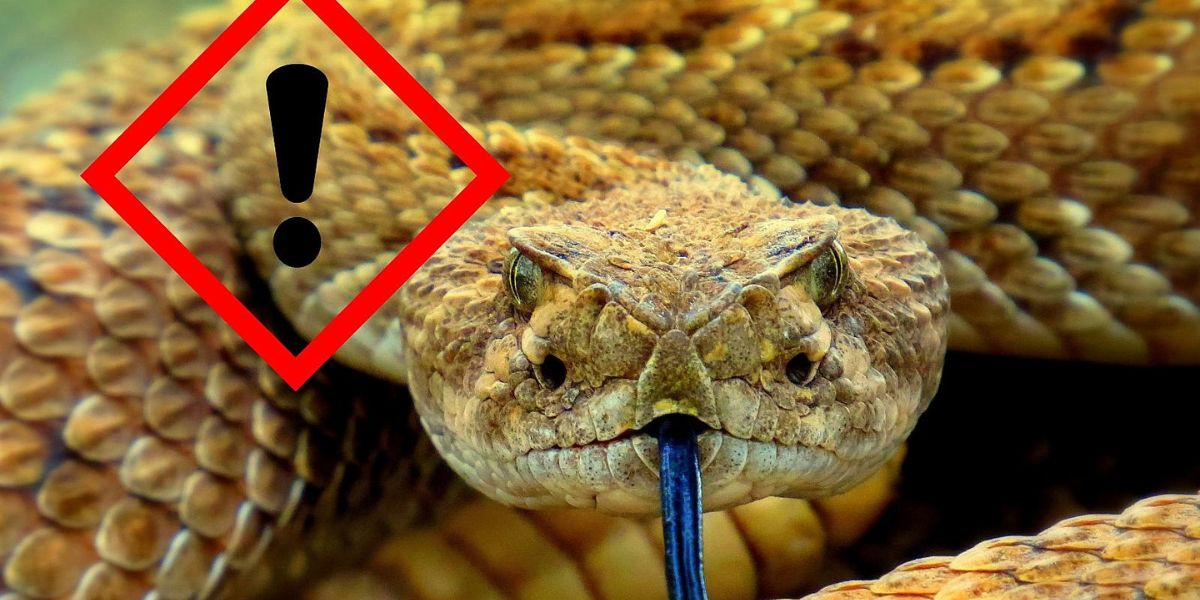The 31 snake species and subspecies that call Utah home thrive in the state’s arid, desert climate.
In contrast to non-venomous snakes, which often have round pupils and longer snouts, Utah’s venomous snakes typically have slitted eyes and broad, triangular heads. If in doubt, stay away and pretend the snake is poisonous.
The list of Venomous snake species found in Utah is provided below so you can become familiar with their characteristics, habitats, and behaviors.
Additionally, keep in mind that these species are most active in the late spring and early summer during dawn and dusk.
Mojave Desert Sidewinder
The Mojave Desert Sidewinder, or Crotalus cerastes cerastes, belongs to the viper family. It is found in southwestern Utah, and southwestern Washington County is where all reported sightings have occurred.
At 24.2 inches in length, the Mojave Desert Sidewinder is quite modest. Because of its dusky tint, the pallid snake blends in perfectly with the sand. However, they do feature black markings that can be yellow, gray, or tan.
This species consumes birds, lizards, small mammals, and occasionally other snakes. Because it only injects a tiny amount of venom while biting, it usually poses little threat to people.
Great Basin Rattlesnake
The most prevalent species of rattlesnake in the state, it is primarily found in high-elevation rocky terrain, however it can also be found in plains, grasslands, and thickets.
Male Great Basin Rattlesnakes have larger heads than females, and they can grow up to 48 inches in length.
Rattlesnakes hibernate during the bitterly harsh winter and come out in the spring, when they are busy and searching for food and water. They consume rodents, lizards, and sometimes birds.
It’s crucial to keep a look out on them on the trails because their coloring helps them blend in with their surroundings. Rattlesnakes prefer to rest on logs, ledges, or warm rocks to absorb sunlight, so pay close attention to these spots.
Dangerous Snakes Are Taking Over These 4 Louisiana Lakes: Avoid Them!
Midget Faded Rattlesnake
The Midget Faded Rattlesnake, or Crotalus oreganus concolor, is one of the smaller species of rattlesnakes, as its name would suggest. Its length is less than 24 inches.
It is located in eastern Utah’s Green River Basin and favors rocky hillsides with plenty of cover, such as overhangs, fissures, and thickets.
Although these snakes are typically found on the ground, they have been observed hiding in trees and plants. In colder climates, when they are dormant, they will also crawl into tunnels or caves.
The Faded Midget Rattlesnakes typically have faint oval markings on their back and are tan, cream, or yellowish in color. These markings, which are dark when the snake is young, turn silver or grey as it gets older.
Because it contains a strong neurotoxic and myotoxin that paralyzes victims, their venom is more toxic than that of most rattlesnakes. They consume amphibians, lizards, birds, and small mammals.
Warning: These are the 5 Most Rattlesnake-Infested Areas in Texas
Prairie Rattlesnake
Of all the rattlesnake species, the Prairie Rattlesnake (Crotalus viridis viridis) has the widest distribution, occurring all over the United States.
The southeastern region of Utah is home to the majority of Utah’s open grasslands and prairies.
The head of a prairie rattlesnake is broad and trapezoidal, and its snout is blunt. They are green or brown with brown or black dots surrounded by dark and light lines, and they can grow up to 60 inches in length.
This species can be found in woods, shrubs, caverns, cliffs, and even beside streams, however they prefer open grass.
Their bite is strong; a single blow can release 20–55% of their venom. As a hemotoxin, its venom damages muscular tissues and circulation by destroying blood cells.
Southwestern Speckled Rattlesnake
The snake is active from April to October, hibernating in dens during the winter months and favoring rocky and desert scrub habitats.
The Southwestern Speckled Rattlesnake may reach a length of 43.7 inches and comes in a variety of colors.
They can be grey, black, white, blue, or pinkish. Because of its diverse coloration, the snake may blend in with its surroundings, whether they are made of brown sand, white stone, or red rocks.
In order to survive during dry spells, this hardy rattlesnake has an odd habit called “rain harvesting,” whereby it utilizes its body to gather and store rainfall.
To Conclude
If you come across a venomous species, back off gradually and alert everyone around. If you are bitten, keep the area below your heart, take off any jewelry or tight clothing, and get medical help right away.
Avoid using a tourniquet, applying cold, or trying to suck the poison out. And don’t freak out. Snake bite deaths are very uncommon.
Like most wildlife, snakes prefer to be left alone and will only strike as a last resort, so don’t allow your fear of snakes stop you from taking in Utah’s stunning landscapes and natural wonders.







Leave a Comment